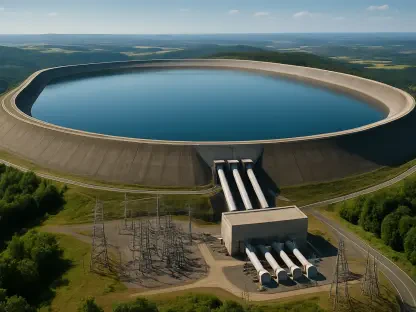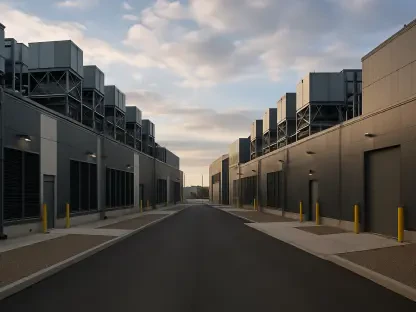The Highgate Hydropower Dam in Franklin County, Vermont, is central to providing electricity to nearly 3,800 local customers across various communities, including Swanton Village, Swanton Town, Highgate, and St. Albans. Renowned for delivering affordable power, the dam facilitates some of the state’s most competitive energy rates. However, its integrity is under threat due to significant damage to its rubber bladder, which is essential for water retention. The repercussions of this tear could drastically alter current power dynamics, challenging local authorities to explore immediate operational solutions to sustain economic viability and avoid costly power alternatives.
Immediate Repair or Lengthy Overhaul?
Viability of a Quick Fix
Recent diagnostics reveal that the tear in the dam’s protective rubber bladder spans approximately 14 to 16 feet. This damage poses a dilemma for Vermont’s energy sector, presenting two primary options for resolution. The first, a direct repair effort aimed at completion by fall, pending federal approval, promises a straightforward and economical solution. Should regulatory bodies grant the necessary permissions, this approach could enable a return to full-power generation by September, mitigating potential financial strain on both authorities and consumers. The expeditious nature of this solution aligns well with the region’s desire to sustain economic stability through uninterrupted, affordable power delivery.
Prospective Long-Term Renovation
Conversely, the second alternative involves a comprehensive overhaul, projected to span up to two years. This path entails considerable expense and infrastructure challenges, requiring dependency on external power sources to fill the gap during reconstruction. Although this substitution may not immediately disrupt end-users, local agencies would bear increased costs, procuring electricity at higher rates. The financial implications would cascade into wider economic burdens, challenging existing fiscal structures and potentially elevating end-user expenses over time. This option, despite its extended timeline, assures a robust upgrade, promising enhanced long-term resilience and functionality.
Economic and Social Implications
Importance of Affordable Energy
The narratives echoed by key officials, including Bill Sheets, the Swanton Village Manager, and Brian Savage, the Swanton Town Manager, highlight the dam’s invaluable contribution to maintaining low energy rates—critical for economic competitiveness. While Bill Sheets emphasizes the ramifications for consumer affordability, Brian Savage underscores the broader economic impact facilitated by competitive power pricing. Each perspective converges on the premise that the dam is integral to the region’s socioeconomic fabric, offering stability and an essential competitive edge in cost-sensitive markets. Thus, any approach to remediation bears significant weight in preserving community welfare and affordability.
Broader Community Impact
Beyond immediate fiscal concerns, perceptions of the dam’s broader influence extend into social dynamics, where its capacity to sustain affordable energy elevates community cohesion and economic strength. As the threat to its operations looms, questions arise about its continued role in supporting local businesses and residential consumers alike. The dam contributes not only to individual economic relief but also reinforces the competitive position of these communities within broader state frameworks. Therefore, the urgency extends to ensuring the dam’s future reliability, with stakeholders acutely aware of its potential to disrupt socio-economic balance if left unresolved.
Navigating the Repair Dilemma
Technical and Regulatory Challenges
The intricacies of executing repairs extend beyond the technical scope, encompassing regulatory compliance and financial feasibility. The engagement of federal oversight and approval processes means that even the most straightforward projects must navigate bureaucratic channels prior to initiation. This regulation-heavy landscape intensifies pressure on decision-makers, demanding efficient handling and substantive justification of chosen pathways. The requirement to ensure alignment with national standards intersects with fiscal constraints, necessitating a nuanced approach that optimizes resources while adhering to broader compliance frameworks.
Ensuring Future Resilience
Given the dam’s pivotal role in supplying affordable electricity, remedies must emphasize not just immediate recovery but also future resilience. The process illuminates how intertwined infrastructure reliability is with community well-being, presenting opportunities for strategic enhancements that bolster current operations against unforeseen contingencies. As stakeholders deliberate, considerations extend to reinforcing the dam’s capacity while seeking to balance operational demands with the pragmatic realities of regulatory environments. Overall, decision-makers aspire to secure long-term infrastructural efficiency and durability, safeguarding essential service supply while adapting to evolving regional energy requirements.
Conclusion: Balancing Complexities with Community Needs
The Highgate Hydropower Dam, located in Franklin County, Vermont, plays a crucial role in supplying electricity to around 3,800 consumers spread across communities such as Swanton Village and Town, Highgate, and St. Albans. It is well known for providing some of the state’s most competitive energy rates, making electricity affordable for locals. However, the dam is facing a significant challenge; a critical tear in its rubber bladder, an essential component for water retention, threatens its operational integrity. This damage could profoundly impact power distribution in the region, forcing local authorities to urgently seek solutions to maintain economic stability. The need for rapid intervention is pressing, as the potential shift in power dynamics could lead to more expensive power alternatives if not addressed promptly. To ensure continued affordable energy, the local administration must explore immediate operational strategies to mitigate the potential crisis and uphold the economic viability of the region.









